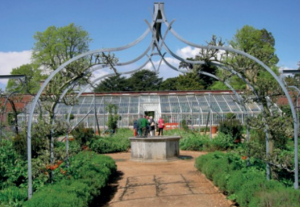 If you need to know more about the challenges of researching and understanding historic parks and gardens Issue 163 of Context, the IHBC’s member journal, Helen Thomas writes about the study and use of historic kitchen gardens by following a 12 month project by the The Isle of Wight Gardens Trust – and why not research the gardens in your local area and see if they share any of the 10 Isle of White walled garden features?
If you need to know more about the challenges of researching and understanding historic parks and gardens Issue 163 of Context, the IHBC’s member journal, Helen Thomas writes about the study and use of historic kitchen gardens by following a 12 month project by the The Isle of Wight Gardens Trust – and why not research the gardens in your local area and see if they share any of the 10 Isle of White walled garden features?
image: Context 163, p40 – Helen Thomas
…typical features of a walled kitchen garden…
Helen Thomas writes:
The Isle of Wight Gardens Trust, unable to resist the attraction, embarked in 2014 on a 12-month project, aided by a small Heritage Lottery grant, to increase understanding of the island’s historic designed landscapes and celebrate the Trust’s 25th anniversary… The project concluded with the publication of Walled Kitchen Gardens of the Isle of Wight…
The typical features of a walled kitchen garden in its heyday might have included:
- High walls (of stone, brick or a combination, with the warmer brick on the inner face) provided support for fruit trees, a micro-climate within the garden, and security.
- Entrances (owners’ entrances generally face towards the house and/or are in the south wall so that the garden was seen to best effect; gardeners’ entrances were plainer, and often in the north or east walls).
- Straight paths (dividing the planted areas into practical square or rectangles known as quarters).
- Dipping pond or well (often at the centre of the garden), a practical and ornamental feature.
- Perimeter borders (allowing space for fruit trees to be trained on both sides of the walls).
- Glasshouses (built on south-facing walls for maximum sunlight and heated from a boiler housed on the outside of the wall).
- Slips or slip gardens (cultivated areas just outside the walled garden which were used for hardier fruit and vegetables).
- Orientation (an aspect slightly to the east of due south protected fruit blossom from thawing too quickly in the morning).
- Potting sheds (outbuildings, often built against the outside of the northern wall, might include seed and fruit stores, workshops, and bothies for unmarried gardeners).
- Frameyard (generally to the north of the walled garden), an area for cold frames, glasshouses for propagating and hot beds for forcing plants into early growth.
At 45 sites it was discovered that either no evidence or only fragments remained…
The 2014 project raised awareness but did not attempt to answer the question of what degree of change for a new use is acceptable in order to provide, at the least, a benign solution for the future. Walled kitchen gardens may no longer be regarded as a dishonoured and forgotten member of the historic landscape family, but they can be a difficult relative to provide with long-term care.
Read the full article and find out more at
See IHBC NewsBlogs on historic gardens
See more on the Isle of Wight on the NewsBlogs
See Context 163
Reading Context helps IHBC members develop their skills across all of the IHBC’s Areas of Competence, and so is a critical baseline in addressing priorities in Continuing Professional Development (CPD)
To access Context:
- IHBC Members: See your postbox, if you don’t already have it by your desk or bed
- Non-members: Go to the Context Archive
If you have any suggestions for Context articles or other material contact Mike Taylor at: editorial@ihbc.org.uk
See information on Context’s future issues, guidance for authors
Access the online archive
See more IHBC background and guidance on IHBC CPD and on how you might use past, current and future issues of Context
 See the formal guidance paper on IHBC CPD (scheduled for update)
See the formal guidance paper on IHBC CPD (scheduled for update)
See more on the IHBC Competences and Areas of Competence

